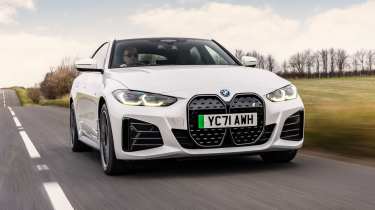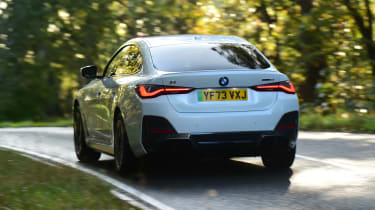BMW i4 eDrive35 review: does less equal more?
BMW’s cheapest i4 gets a smaller battery, less power and a £50,755 price tag – is it a worthy alternative to a Polestar 2?
The biggest compliment you can pay the BMW i4 is that, for the most part, it feels like driving a 3-series while wearing earplugs. In its transition towards electric cars, BMW is adapting some existing ICE platforms to accept battery power, and while that might sound like a compromise, it gives models like the i4 a pleasing familiarity, and the same attributes that have kept the 3-series at the top of its game for years.
The i4 has been around since 2021, initially launching in eDrive40 and dual-motor, 537bhp M50 forms. The eDrive35 we’re testing here arrived later, getting a less powerful single rear motor and a smaller 67kWh battery than the eDrive40, but with an £8k price saving to match.
What does your £50,755 buy you? In short, the most polished EV saloon to drive in this price bracket. Make no mistake, the i4 isn’t an out and out thriller, but rivals like the Tesla Model 3 and Polestar 2 lack some of the finesse and adjustability BMW has engineered into the package. It starts with the steering, which thanks to bracing arms across what would be the engine bay in a 4-series, has clean, uncorrupted responses and great accuracy. It doesn’t load up and feed your hands with information, but it's distinctly BMW-like in feel.
More reviews
Our test car didn’t come with adaptive dampers, but the passive set-up strikes a sensible balance between control and comfort. Drive gently and the i4 doesn’t feel like a 2065kg car, and while it doesn’t completely suppress harsh road imperfections, it’s generally fluid and calm at a cruise.
This measured, restrained feel extends to the powertrain – with 282bhp and 295lb ft of torque the eDrive35 is easily outsprinted by Tesla’s similarly-priced Model 3 Long Range, but the BMW surges along effortlessly from low speed and is flexible enough for daily driving. It reaches 62mph in six seconds flat, and we don’t see a need to go any faster in this type of car.
There’s also the fact that all the power is going through a relatively skinny pair of 225-section rear tyres. The balance between grip and slip is well judged, and the i4 feels secure and predictable right up to the limit. Carry too much speed and it falls into mild, easily manageable understeer, but it’s possible to neutralise the car with throttle and indulge in the rear-drive balance, which is again very reminiscent of an ICE-powered BMW saloon. Unlike some EVs, the i4 isn’t hard to read when you start to overdrive the rear tyres, and there are fleeting moments of fun to be had.
Cracks – and pretty big ones – start to emerge when you ask more questions of the chassis and suspension. On one of the most technically challenging roads we know in Wales, the i4 seemed to give up its composure and completely unravel, which came as a genuine surprise given the control it demonstrated everywhere else. Tricky cambers and successive bumps found the limits of the suspension as the body rocked awkwardly across the axles, muddying the car’s responses and sapping confidence. It suddenly felt every bit as heavy as it is on paper, which it didn’t during most of our time with the car, it must be said.
Inside, the i4 is pretty much business as usual as far as BMW interiors go. Build quality is excellent and a step beyond that of a Polestar 2, and the curved, dual-screen iDrive infotainment system is among the very best in the business. The driving position and primary controls set-up is better than in any rival too – overly thick steering wheel aside – but rear seat passengers suffer from the packaging needs of the underfloor battery pack. The footwell isn’t deep enough in relation to the rear bench seat, which makes long trips a little uncomfortable for taller adults.
Speaking of long trips, the eDrive35 can cover up to 299 miles (WLTP) from a full charge, which isn’t very impressive against the 390-mile Tesla Model 3 Long Range and the 406 miles achieved by the equivalent Polestar 2. You’ll need to cough up the extra £8k for the eDrive40 if you need extra range, and that car’s 365-mile WLTP figure does put it much closer to the i4’s direct rivals while also offering a boost from 180kW to 205kW charging capability. The i4 might not offer the headline numbers and exceptional value of a Tesla, but by almost every other metric it’s hard to beat.






